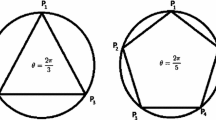Abstract
This study suggests that the power law decay of prime number distribution can be considered a sub-diffusion process, one of typical anomalous diffusions, and could be described by the fractional derivative equation model, whose solution is the statistical density function of Mittag-Leffler distribution. It is observed that the Mittag-Leffler distribution of the fractional derivative diffusion equation agrees well with the prime number distribution and performs far better than the prime number theory. Compared with the Riemann’s method, the fractional diffusion model is less accurate but has clear physical significance and appears more stable. We also find that the Shannon entropies of the Riemann’s description and the fractional diffusion models are both very close to the original entropy of prime numbers. The proposed model appears an attractive physical description of the power law decay of prime number distribution and opens a new methodology in this field.
Similar content being viewed by others
References
R.L. Bagley, Power law and fractional calculus model of viscoelasticity. AIAA J. 27 (1989), 1412–1417.
A.M. Balk, Anomalous diffusion of a tracer advected by wave turbulence. Phys. Lett. A 279 (2001), 370–378.
L. Bartolo, and L. Lacasa, The first-digit frequencies of prime numbers and Riemann zeta zeros. Proc. R. Soc. A 465 (2009), # 2197.
H.M. Bui, and J.P. Keating, On twin primes associated with the Hawkins random sieve. J. Number. Theory 27 (2006), 284–296.
W.W.L. Chen, Distribution of Prime Numbers. Macquarie University, Sydney (2003).
W. Chen, S. Hu, and H. Sun, A speculative study of anomalous relaxation modeling for the distribution of prime numbers. In: MESA, IEEE/ASME International Conference (2010), 517–521.
W. Chen, H. Sun, X. Zhang, and D. Korosak, Anomalous diffusion modeling by fractal and fractional derivatives. Comput. Math. Appl. 59 (2010), 1754–1758.
G.H. Cuellar, E.J. Lopez, E.C. Canton, and A.N. Pisarchik, An approach to generate deterministic Brownian motion. Commun. Nonlinear Sci. 19 (2014), 2740–2746.
A. Fertis, M. Baes, and H.J. Luthi, Robust risk management. Eur. J. Oper. Res. 222 (2012), 663–672.
D. Goldfeld, The elementary proof of the prime number theorem: An historical perspective. In: Number Theory, New York Seminar (2003), 179–192.
C. Ingo, R.L. Magin, L.C. Perez, W. Triplett, and T.H. Mareci, On random walks and entropy in diffusion-weighted magnetic resonance imaging studies of neural tissue. Magnet. Reson. Med. 71 (2014), 617–627.
K. Jayakumar, and R.P. Suresh, Mittag-Leffler distributions. J. Ind. Soc. Probab. Statist. 7 (2003), 51–71.
B.L. Lan, and S. Yong, Power spectrum of the difference between the prime-number counting function and Riemann’s function: 1/f2?. Physica A 334 (2004), 477–481.
Y.J. Liang, and W. Chen, Bridge fatigue life prediction using Mittag- Leffler distribution. Fatigue Fract. Eng. Mater. Struct. 37 (2014), 255–264.
Y. Liang, and W. Chen, Reliability analysis for sluice gate anti-sliding stability using Levy stable distributions. Signal Process. 107 (2015), 425–432.
M.A.S. Lozano, G.J.F. Barbero, and J.N. Salas, Prime numbers, quantum field theory and the Goldbach conjecture. Int. J. Mod. Phys. A 27 No 23 (2012), # 1250136.
F. Mainaridi, and R. Gorenflo, On Mittag-Leffler-type functions in fractional evolution processes. J. Comput. Appl. Math. 118 (2000), 283–299.
R. Metzler, and J. Klafter, The random walk’s guide to anomalous diffusion: A fractional dynamics approach. Phys. Rep. 339 (2000), 1–77.
D.A. Murio, On the stable numerical evaluation of Caputo fractional derivatives. Comput. Math. Appl. 51 (2006), 1539–1550.
R.N. Pillai, On Mittag-Leffler functions and related distributions. Ann. Inst. Statist. Math. 42 (1990), 157–161.
P. Pollack, Revisiting Gauss’ analogue of the prime number theorem for polynomials over a finite field. Finite Fields Th. App. 16 (2010), 290–299.
M.H. Saeidirad, A. Rohani, and S. Zarifneshat, Predictions of viscoelastic behavior of pomegranate using artificial neural network and Maxwell model. Comput. Electron. Agr. 98 (2013), 1–7.
J. Sherman, M.P. Molloy, and A.L. Burlingame, Why complexity and entropy matter: Information, posttranslational modifications, and assay fidelity. Proteomics 12 (2012), 1147–1150.
M.F. Shlesinger, On the Riemann hypothesis: A fractal random walk approach. Physica A 138 (1986), 310–319.
H. Sun, M.M. Meerschaert, Y. Zhang, J. Zhu, and W. Chen, A fractal Richards’ equation to capture the non-Boltzmann scaling of water transport in unsaturated media. Adv. Water Resour. 52 (2013), 292–295.
Z. Tshiprut, A.E. Filippov, and M. Urbakh, The effect of lateral vibrations on transport and friction in nanoscale contacts. Tribol. Int. 40 (2007), 967–972.
F. Vericat, A lattice gas of prime numbers and the Riemann Hypothesis. Physica A 392 (2013), 4516–4522.
K. Weron, and M. Kotulski, On the Cole-Cole relaxation function and related Mittag-Leffler distribution. Physica A. 232 (1996), 180–188.
M. Wolf, Random walk on the prime numbers. Physica A 250 (1998), 335–344.
A. Yildirim, M.D. Oner, and M. Bayram, Fitting Fick’s model to analyze water diffusion into chickpeas during soaking with ultrasound treatment. J. Food Eng. 104 (2011), 134–142.
Author information
Authors and Affiliations
Corresponding author
About this article
Cite this article
Chen, W., Liang, Y., Hu, S. et al. Fractional derivative anomalous diffusion equation modeling prime number distribution. FCAA 18, 789–798 (2015). https://doi.org/10.1515/fca-2015-0047
Received:
Published:
Issue Date:
DOI: https://doi.org/10.1515/fca-2015-0047



